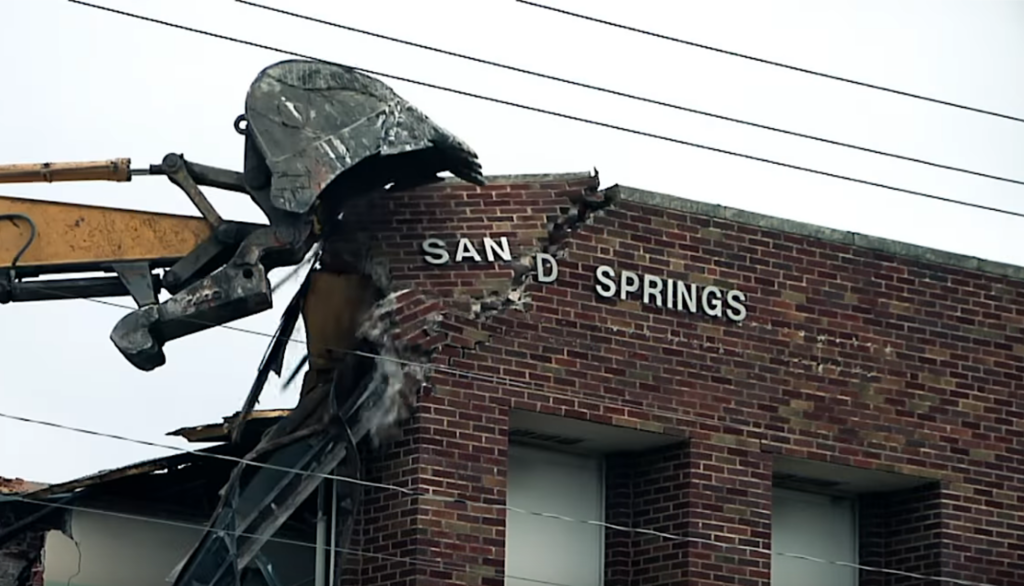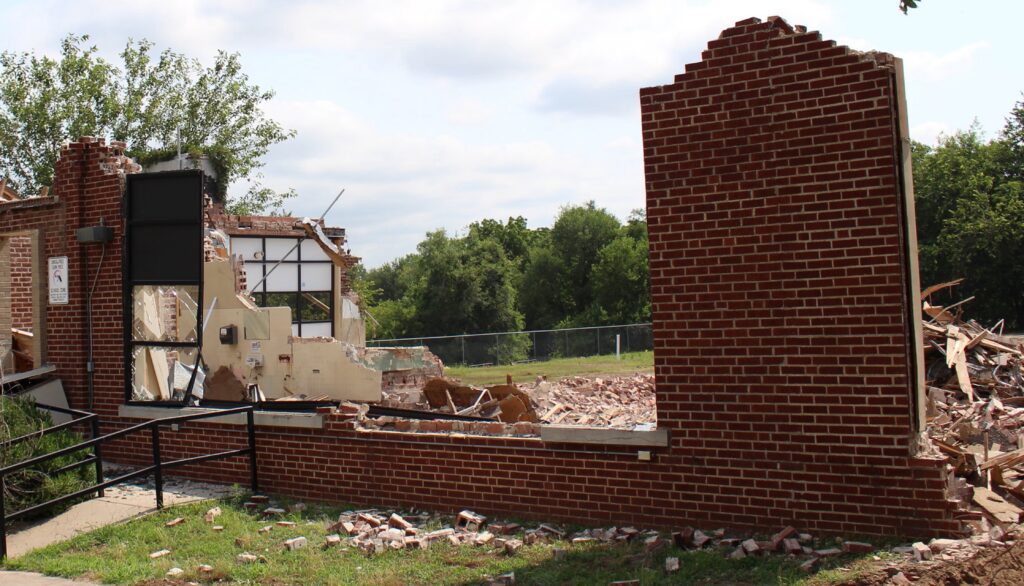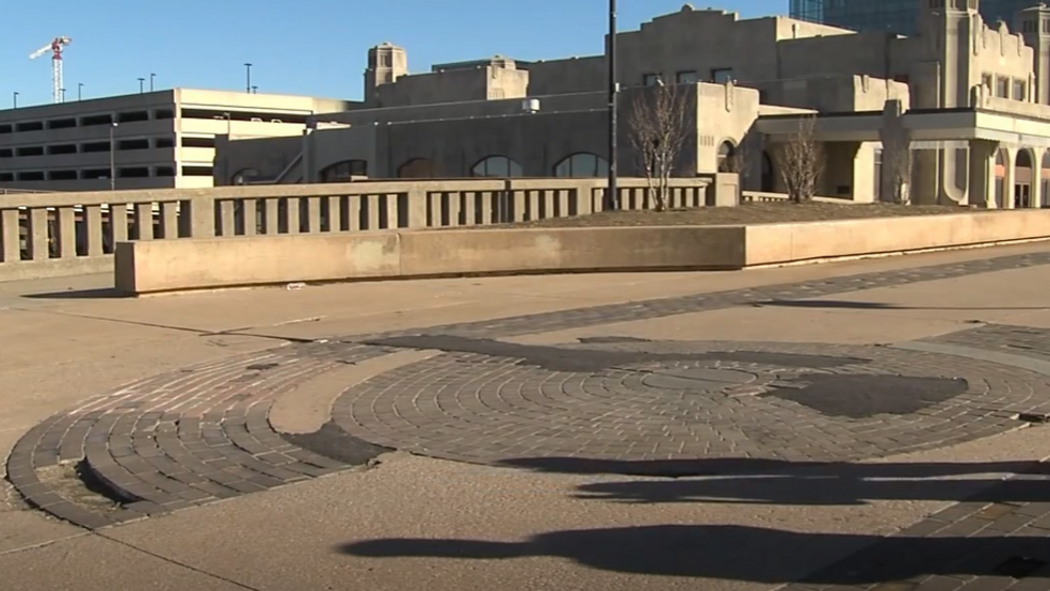
By John Neal, The Oklahoma Eagle
Contributor, Gary Lee
Photography, Cory Young
By the fall of 2004, Sand Springs city authorities were ready to push through a new “Urban Renewal” plan that would wipe out the entire Black community in the urban core of the city, including the longtime homes of dozens of Black families. A couple of hurdles remained, and they were significant. One was how to maneuver the plan through a web of legal requirements? And another: how to railroad this project through the Black residents?
Apparently, the forces behind the renewal project had hatched schemes to deal with both challenges. Their response to the second issue centered around a blatant disregard of the sentiments of Blacks in the community. When Irving Frank, an Indian Nation’s Council of Governments (INCOG) official and the apparent mastermind of the plan, presented it in a meeting of the Sand Springs Planning Commission on September 21, 2004, he told the gathering: “It appears those businesses impacted as well as residences and churches are satisfied with the plan and are anxious to move forward.”

As Sand Springs city officials pushed forward a controversial urban renewal project, David Rose said the strong opposition from the African American community was ignored at each step in the process. “But you have to remember that these were just normal folks up against some pretty powerful forces,” Rose, a North Tulsa resident whose family was a vital part of the Sands Springs Black community for several generations. “Beyond making clear that they were unhappy with the plan, they seemed powerless,” he said in an interview with The Oklahoma Eagle. JOHN NEAL
As Frank was undoubtedly aware, the opposite was the case. During public meetings held weeks earlier, Black residents of Sand Springs had voiced their discontent with the plan in public gatherings. KOTV, the CBS affiliate in Tulsa, had reported disapproval of the plan during the summer of 2004: “City Planners estimate about 177 people would have to move,” one KOTV report said. “And many of these folks aren’t happy about that prospect.”
Nonetheless, city officials pushed forward with the renewal project. And at each step, disregard for the sentiments of Black residents was apparent.
The residents continued to express their disapproval. “But you have to remember that these were just normal folks up against some pretty powerful forces,” said Donald Rose, a North Tulsa resident whose family was a vital part of the Sands Springs Black community for several generations. “Beyond making clear that they were unhappy with the plan, they seemed powerless,” he said in an interview with The Oklahoma Eagle.
Strategy to wipe out Black community
Sand Springs officials also appeared to have a strategy to keep within the confines of the law as they proceeded to wipe out the Black community. They would skillfully use every possible loophole or loose interpretation of statutes in ways that would help them.
The action to exercise the power of eminent domain is one example. Proceedings to do that started on May 22, 2006. The SSDA acting as the Urban Renewal Authority could have worked without the City Council approval, but Oklahoma law required the governing body to act when used against unimproved real estate or, in this case, 11 vacant lots.
Another example of the Corridor Plan mischaracterization in its demographic portrayal of “Area A.” The Corridor Plan reflects an abundance of ignorance or deceit in not providing accurate demographic information. Instead, it merely notes, “The demographic data for the Corridor Plan area, according to the 2000 U.S. Census, is shown in Appendix C. of the Plan. It asserts that “84 persons or 47.5% of the Residential Study Area is African American alone.”
And yet, even a minimal amount of due diligence would have had the Corridor Plan identifying the area as a Black neighborhood, corresponding to Area A. Using the study’s owner-occupied house count (68) and persons per household (2.36) in Area A, (the Black neighborhood) approximately 160 persons were living there, and they were all Black. Thus, this neighborhood was home to half of all African Americans residing in Sand Springs at that time.
According to our review of records, the public participation process was, at best, flawed. We noted that the Corridor Plan was being presented “after” the project’s approval in a sales tax referendum. The initial public meetings in the Corridor Plan were not made by the governing body. They were the Sand Springs Development Authority meetings, the newly designated Urban Renewal Authority. The Plan said these public meetings were “not required.” That characterization appeared to ignore the Oklahoma Open Meeting Act in effect at that time.
These public meetings were held several months or more before the City Council would ultimately adopt the Plan. The scope of this amended Urban Renewal Plan and its impact on people’s lives and property deserved a more truthful and transparent public participation process.
Opposition to the plan
On October 11, 2004, the City Council met to approve the plan. Only one public notice had been posted to announce the meeting on September 26, 2004. No newspaper articles preceded it in the Sand Springs Leader.
But the Leader reported on the meeting, and its article reflected that there was considerable opposition to the plan in the Black community.
It featured a quote from Lloyd Johnson, a resident of the affected area. “Johnson spoke on behalf of a good number of the residents in Area A that would be displaced by the redevelopment. “‘We are those crying in the wilderness,’” Johnson was quoted as saying. “‘We do not know when we are going… we’re just told we’re going. “
The article continued that “Johnson added that ‘many of the residents are older.’ and ‘worrisome.’ Johnson also shared pictures of those (homes) available in Sand Springs.” (homes). ‘Some of those are not as good as the ones we’re living in.’”.
But when Sand Springs officials posted minutes of the meeting, they did not reflect any of these sentiments. They simply and officially recorded Mr. Johnson’s comments as having been that they wanted to be only “paid fairly for their homes” and “kept informed of the plan’s progress.”
The Sand Springs Leader article also included a mischaracterization that would prove ominous. “Following a public hearing on what is still being called a preliminary draft, the Sand Springs City Council Monday night approved the Keystone Corridor Redevelopment Plan,” the article said. As events would later demonstrate, it was neither a draft nor preliminary.

As Sand Springs city officials pushed forward a controversial urban renewal project, David Rose said the strong opposition from the African American community was ignored at each step in the process. “But you have to remember that these were just normal folks up against some pretty powerful forces,” Rose, a North Tulsa resident whose family was a vital part of the Sands Springs Black community for several generations. “Beyond making clear that they were unhappy with the plan, they seemed powerless,” he said in an interview with The Oklahoma Eagle. JOHN NEAL
Eminent Domain
Area A, the Southside Addition, had been designated as one of the critical areas for demolition. This section of Sand Springs was created as a segregated place of residency by the town founder in 1911. In the early 2000s, the city was still primarily segregated in housing. The Corridor Plan, or any plan for that matter, which considered this neighborhood, should have weighed the impact of their dislocation and destruction of their homes and other property, placing the residents’ needs and desires at the forefront. But like so many places across America, Urban Renewal had the effect, if not intent, to “move the Negroes out,” as the prominent Black writer James Baldwin observed in 1963.
When the eminent domain was invoked as the reason for targeting this humble Black neighborhood in the fall and winter of 2005, it sparked a national outcry. The National Review Online called it an “unholy takeover.” The New York Times also weighed in. Churches banded together to protect the three Black churches in the neighborhood from property seizure. City officials sought to characterize the redevelopment area as just an “old industrial area” and a “golden opportunity.”i
In its description of the neighborhood, the Corridor Plan said, “Since its initial development and reaching its prime, the area has been characterized by vacant lots, dilapidated vacant residential and commercial buildings….” As anyone familiar with the neighborhood knew, the description was false. And when the controversy surrounding the use of eminent domain became known, Sand Springs City Manager Loy Calhoun, only days after the reports, would say, “There is no eminent domain action going on there. No action, no intents- nothing like that’s been done in the area.”
A few months later, the Tulsa World ran an article about the issue with the following headline: “Sand Springs Council OKs Condemning 14 Properties. “That meeting was May 22, 2006. The condemnation proceedings included 11 vacant lots, one occupied and two unoccupied single-family structures. All but one Council member approved the action. That Council member said some of the properties met the definition of blight, while others were viable lots.
In a recent interview with the Oklahoma Eagle, Mayme Crawford, a longtime activist in the Sand Springs Black community, concurred. “There seemed to be a big rush to get those demolitions done,” she said. “And in that rush, they overlooked the fact that some of the homes were in decent shape and could easily be preserved.”
Blight conditions may have been exacerbated because nearly 75% of the occupied residences were rental properties and landlords likely knew years in advance these properties would be taken. An INCOG representative told the City Planning Commission that “the Corridor Plan dates back to 1980…with city planners”. Beginning in the 1950s and completed in 1973, an expressway was built between Black and white communities in the 1950s and 1973. It reinforced segregation and contributed to the deterioration in the Black neighborhood.
The church that fought back
The Centennial Baptist Church, a predominately Black place of worship, located in the area pinpointed for demolition, pushed back. It was not among the properties condemned on May 22. Church leaders steadfastly refused buyout offers. At one point, the church pastor, Reverend Roosevelt Gildon, said, “The Lord didn’t send me here to build a mini-mall.” And in a letter to the City, the church’s legal counsel, the Becket law firm, promised that the use of “… eminent domain will be challenged by immediate legal action.”
In its summary of the case, the law firm reported its letter “further cautioned the city that “the Church’s right to engage in religious exercise on its property, free from government burden and interference, is fully protected by the First and Fourteenth Amendments of the United States Constitution, the Oklahoma Religious Freedom Act, and the Religious Land Use and Institutionalized Persons Act of 2000.”
Two critical factors turned out to be in the church’s legal favor. The property was not part of the alleged blight, having been remodeled just years before, though it had been swept up in the City Council’s former blight resolution.
The second reason was that city official had relied on economic development or redevelopment as its reason to exercise these powers until this point. And in Kelo vs. New London et al., the United States Supreme Court in June 2005 affirmed that the use of economic development was a “public purpose.” So, the City of Sand Springs had proceeded with confidence that “economic development” could be used as the basis for the taking.
However, the U.S. Supreme Court had noted that the City of New London had relied on an invocation of a “State statute… to effectuate this plan”.ii Thus, the Court left it to each State’s constitution and laws to determine whether eminent domain for economic development was a valid public purpose. Unfortunately for the City of Sand Springs, on that May 22, 2006, meeting day, the Oklahoma Supreme Court had, thirteen days earlier, invalidated using eminent domain for private economic development. It did affirm its use for blight. So, the city reversed its well-publicized position that this was a “redevelopment plan” to being all about blight. And the church was one of the numerous structures in the designated area that were not blighted. The city dropped its case against the church. City Attorney David Weatherford said, “there’s no reason to” (use eminent domain). The church still stands on the same site.

As Sand Springs city officials pushed forward a controversial urban renewal project, David Rose said the strong opposition from the African American community was ignored at each step in the process. “But you have to remember that these were just normal folks up against some pretty powerful forces,” Rose, a North Tulsa resident whose family was a vital part of the Sands Springs Black community for several generations. “Beyond making clear that they were unhappy with the plan, they seemed powerless,” he said in an interview with The Oklahoma Eagle. JOHN NEAL
Booker T. Washington School
The Early Childhood Center, another property in the Southside addition, also warrants special attention. The Sand Springs School District owned it. The building had been the Booker T. Washington School in an earlier era. Black students of all grades in Sand Springs had been educated there for half a century until the integration of public schools in 1966. If you were a Black student in Sand Springs in the first half of the 1900s, it was likely your home school. It was briefly a Head Start facility before being converted to an Early Childhood Center (public school kindergarten) and was still being used for that purpose.
The School District had no reason to sell the property. And the City could in no way characterize it as blighted.
But the City was determined to tear the building down. In 2006 the City and the school district came to terms. The City would pay a staggering $3.5 million for the “blighted” property and would not take it until a new kindergarten was built elsewhere in 2009. This single purchase represented 37% of the Plan budget for acquisition, clearance, and relocation. This marked another major blow to the Black community and its heritage.
“It’s astounding that the city paid this kind of money for the building and then turn around and abolished it,” said Donald Rose, whose mother graduated from the school. “It points to the fact that someone was on a mission.”
Greed fueled the plan
At its core, the Corridor Plan was designed to attract the “40,000 motorists a day on the Expressway… to create a point of destination… for commercial and retail services for customers across the region”.iii This would include for Area A “major retail stores, restaurants, specialty retail shops and services.”iv
The taxpayers would pay for the property and its demolishment, and the city would be the beneficiary of additional sales and property taxes. One could easily reason that is why the project was conceived. For example, and continuing with the BTW school experience, a CVS pharmacy replaced it. In 2020 it had a tax fair market value of $2.7 million and was paying $36,663 in property tax annually and inestimable sales taxes. Thus, a tax-generating business replaced a school.
What overall effect has this redevelopment had on the city’s sales and property tax revenue? Sales tax is the primary source of income for funding municipal government operations, and property tax is used to pay the debt. While the full impact cannot be known because some properties are still vacant, thirteen (13) major commercial and retail service businesses are in the former, now displaced, Black neighborhood. Some effects can be measured. For example, the City’s 2020 Comprehensive Annual Financial Report (CAFR) shows sales tax increasing from $9.2 million in 2011 to $14 million annually in 2020. Adjusting out the portions that were contributed by a higher sales tax rate in 2017-2020, this is a 31% increase over a nine (9) year period. Between 2013 and 2020, property tax increased by 34%. Most of the growth occurred from 2017-to 2020 following the great recession and when many of the new businesses were added in the redevelopment area.
Had Sand Springs relied solely on its internal population growth for increases in sales and property taxes, and thus its resident-based purchasing power, the growth would have been a mere 6% over the same period. Of course, not all of this 30%+ tax growth is solely attributable to the commercial redevelopment effect. Still, no one can doubt it represents a sizeable chunk of the growth as the Corridor Plan anticipated.
What was the human and cultural cost?
City Manager Elizabeth Gray noted in 2019. “After Vision 2025, the city made a very conscientious effort to invest in itself.” (Keystone Corridor Redevelopment project). “We took a blighted area and turned it into River West Shopping District. That’s probably been the biggest catalyst of any.”
But at what human and cultural cost, and by what means? Sixty-eight families lost their homes, two churches, and their historical school. The Black neighborhood that had been there for a hundred years at the town’s founding disappeared victims of commercial profits and tax greed.
For former and current Black residents of the area, the lack of markers or monuments commemorating the demolished neighborhood is particularly unsetting. “The neighborhood had a vibrant history,” said Janice Ross, who grew up in the city’s Black neighborhood and graduated from Booker T. Washington. “There should be some official monument so that people can remember what we had and what we lost.”
In 2013, Crawford, a former Booker T. Washington alumni, and resident of the Southside Addition, said this of the area, “There were only three or four streets, and that was just the nucleus of the African American community at that time. All of a sudden, there is a radical reconfiguration of the community as if there was never an African American community there.”
Crawford would later note fewer than five of those families would remain in the Sand Springs area.
Reverend Willard Jones, who also lived in the community, echoed the sentiment. “I go through there and cry. There’s not anything there to remind us that this used to be a black community there that was alive and vibrant. We were like one big family there.”
ABOUT THE AUTHOR
John Neal, the author, is a Sand Springs native. He is well-versed in urban renewal, its uses and abuse as a former city manager in Oklahoma and departmental consultant for the city of El Paso, Texas. In 2008, he was that city’s planning director when the city won multiple awards for its planning accomplishments. He is now retired and resides in Austin, Texas.
ABOUT THIS SERIES
Sand Springs native John Neal looks at his hometown’s former Black neighborhood that vanished after being in city since its founding nearly 100 years earlier. In December, wrote a two-part investigation on the integration of Charles Page High School, recounting how the school district did what no other public school in Oklahoma had the courage to do in 1964.










